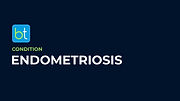BackTable / OBGYN / Podcast / Episode #65
Thoracic Endometriosis: Beyond the Pelvis in Diagnosis
with Dr. Shanti Mohling
Thoracic endometriosis occurs in about 12% of patients with advanced endometriosis. Due in part to its lower incidence and inherent diagnostic challenges, many providers are not well-versed in the workup and management of this advanced disease. In this episode of The BackTable OBGYN Podcast, host Dr. Mark Hoffman interviews Dr. Shanti Mohling, a gynecologic surgeon at Northwest Endometriosis and Pelvic Surgery, regarding her approach to thoracic endometriosis.
This podcast is supported by:
Be part of the conversation. Put your sponsored messaging on this episode. Learn how.

BackTable, LLC (Producer). (2024, September 17). Ep. 65 – Thoracic Endometriosis: Beyond the Pelvis in Diagnosis [Audio podcast]. Retrieved from https://www.backtable.com
Stay Up To Date
Follow:
Subscribe:
Sign Up:
Podcast Contributors
Synopsis
The physicians discuss the embryological and congenital theories of endometriosis etiology, the impacts of retrograde menstruation, and epigenetic factors. Dr. Mohling shares insights into her advanced surgical techniques for treating endometriosis, including diaphragmatic and thoracic disease, and the importance of a comprehensive history, exam, and diagnostic imaging. Her practice patterns, patient care strategies, and interdisciplinary collaborations for optimal outcomes are also highlighted.
Timestamps
00:00 - Introduction
06:40 - Pelvic Pain Workup
08:09 - Thoracic Endometriosis
14:12 - Medical Management Post-Surgery
18:48 - In-Office Ultrasound Techniques
23:33 - Collaboration in Surgery
24:59 - Preparing for Thoracic Endometriosis Surgery
36:44 - Managing Postoperative Care
41:13 - Theories on Endometriosis Etiology
46:31 - Concluding Thoughts
Transcript Preview
[Dr. Shanti Mohling]
Yes, right. That's the biggest question. In a way, I suspect it in everyone. Just, I think it's more prevalent than we realize, although the numbers are that it's going to be up to 12% of people with invasive endometriosis, advanced endometriosis, that are also going to have extra pelvic disease. When I am meeting with someone, and we are pretty sure from their history, from their exam, from their family history, or from prior surgical documentation that they have endometriosis, and they want to have surgery and they want to have either just excision or they want to have excision with hysterectomy, very rarely, but occasionally, also oophorectomy, especially if they're over 50 and have involvement of the ovaries, I'm going to say, "Listen, some of my patients have diaphragmatic disease."
We have a conversation. "One, do you have symptoms? Do you have chest pain? Do you have shoulder pain? Do you have, or if anyone has a history of catamenial, meaning with the menstrual cycle, pneumothorax, or symptoms?" I'm going to have an increased threshold of interest that they might have diaphragmatic or thoracic disease. I start out, before we even go to surgery, I counsel them that I always look, and if I find it, do they want me to remove it?
The Materials available on BackTable are for informational and educational purposes only and are not a substitute for the professional judgment of a healthcare professional in diagnosing and treating patients. The opinions expressed by participants of the BackTable Podcast belong solely to the participants, and do not necessarily reflect the views of BackTable.













